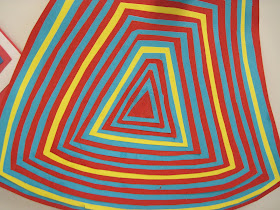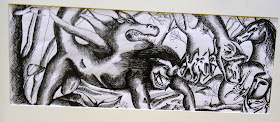Open up the photo above, and step WAY back and look at it. Squinting a little will help. How many colors are there? No doubt you see turquoise, and red, and probably a gold-yellow and a paler yellow. Guess what! The two yellows are actually the identical color! It is an illusion! None of the pieces pictured in the photo below has any more than three colors in it, even though you probably see at least four.
I posted about this intriguing project way back in 2011, but it's a post that hasn't had a lot of views, and it's a really interesting lesson, so I thought I'd share it with you again. This project is designed to show the effect that one color has on another.
The materials are simple: each student will need three sheets of 12"x18" construction paper - two dark colors and one light color. They will also need a ruler, a pencil, a scissors, and glue. That's it!
Watching students decide which colors are light and which ones are dark is actually pretty interesting. I guided decisions if I didn't think their choices would work, but sometimes we were surprised at the outcome. I recommend that the two dark colors be very different from each other - perhaps one warmer and one cooler color. And as long as the two dark choices are darker than the light color, the illusion should work. And if someone really wants to use white for their light, or black for a dark, don't discourage them. You'll never know the result until you actually see it! I had a huge selection of colors to choose from, not just the bright Tru-Rays, but the paler color pastels from cheaper brands. (If you only have the 'good stuff', ask an elementary teacher to trade a few sheets for some pale blues, yellows, or pinks perhaps.)
Then, the papers are labeled in a corner - one dark color is labeled
'A', and one is labeled
'B'. The light color is labeled
'C'. I gave each student a paper clip to hold the papers together at the end of ar class, so they only need to write their name one one sheet of paper (the
C paper).
Also on the
C paper, students copy the following color pattern off the board. Write it on a corner, near an edge, so it doesn't take up too much space on the paper. Here's the pattern:
A-B-A-B-A-B-C,
B-A-B-A-B-A-C,
A-B-A-B-A-B-C,
B-A... until you run out of paper.
A simple shape, no larger than a quarter, is cut out of the
A paper and glued (we used good glue sticks) on the
B paper, starting near a corner but not right on the edge. Each time a new piece is cut and glued onto the next layer, have them cross the letter of what was cut off the written pattern. Following the pattern is essential for the illusion to work.
Use the ruler to find an
1/8", and draw a shape around the original shape, larger by
1/8". Cut out the shape, glue it back onto the
A paper, and cross it off the pattern. Repeat the process. Over and over again, measuring, cutting, gluing, crossing off, measuring, cutting, gluing, using the
A paper, the
B paper, and occasionally the
C paper as per the pattern. Following the pattern is essential, as one time the
C paper will be between two layers of color A, and the next time it will be between two layers of color
B, and so on.
The most important thing to watch is that the kids do NOT skip all
over the paper cutting and gluing, or they will run out of paper too
soon. Start at a corner, and try to snug it in nice and close, each
time you glue it down to cut again. Remember, you only need a border of
1/8". Very rarely, if a student does not pay attention to this
instruction, you may need to give them an additional piece of paper in
order to finish the project. Or, sometimes, if they have a couple of
parts of a paper that are too small, you can have them overlap and glue
them together to create a larger piece.
Once they are done, have kids hold them up at a distance from other students, and then have students taking turns guessing what colors were used. You'll be amazed. Kids will guess as many as 7 or 8 colors on one illusion. You can't see the full effect here on the blog; you have to try it! The colors chosen will give halos of colors to the others, and the kids will absolutely not be able the guess the only three colors that were used. It's really pretty amazing.
By the way, the original lesson for this was not my idea. I found it right here, in the April 2003 issue of
School Arts Magazine!
One last thing - follow-up. Ask the kids how can they think they can use what they learn in their daily lives? Perhaps in clothing choices? In colors they pick to decorate their rooms? I have a purplish carpet in my living room (it is actually subtle blue and red fibers, but visually, it is a dull purple). Years ago, when we had a royal blue rug, the walls were painted a buttery yellow. When we replaced the carpet, and I could not find a tweedy blue like I wanted, we ended up with the purplish rug instead. As a result, because it is next to the yellow walls it looks gray! I can't believe I didn't think about how that would happen when we picked the carpet! (Of course the good side is that you cannot see the cat hair... or maybe that's the bad side?)
Anyhow, try one of these illusions yourself, and you'll want to do it with your students! I did it with 5th graders. You can try younger, if you think the kids could manage the pattern and the measuring, but be warned - if they make the borders much larger than 1/8", the illusion will not be as effective. So I'd do this with students who can carefully measure and follow the pattern. Have fun!





























































